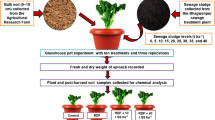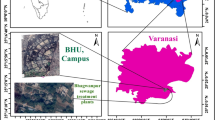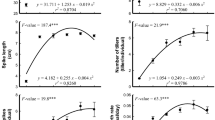Abstract
This work aims at studying the possibility of the safe application of sewage sludge (SS) biosolids as low-cost soil fertilizer to improve soil properties and crop productivity. In the present study, Sorghum bicolor was cultivated in soil amended with SS (0, 10, 20, 30, 40, 50 g/kg) to investigate its impact on soil quality and sorghum yield. Applying SS rates significantly increased growth parameters, total biomass, and absolute growth rate compared to the plants grown in the non-amended (control) soils, whereas 30 g/kg SS had the highest values and was considered as a recommended dose. The induced growth at 30 g/kg SS was accompanied with a significant increment in metals contents in roots, stems, and leaves, and had normal safe limits in the produced grains. After harvesting, the soil quality was improved, and its pH value decreased from 8.4 to 7.7, offering an increased availability of micronutrients. Furthermore, amending S. bicolor with 30 g/kg SS elevated bioaccumulation factor (BF) values over 1 for Cu, Ni, Zn, and Cr compared to the control, indicating its remediating capability with values of 2.32, 1.97, 1.42, and 1.15, respectively. Alternatively, at the recommended SS dose, the upper uptake of Pb significantly increased in the leaves having translocation factor (TF) value of 1.18. The current work proposes that soil amendment with 30 g/kg SS is recommended to enhance soil fertility and plant yield, with no health risks when eating the produced grains, with potential heavy metal phytoextracting by S. bicolor.



Similar content being viewed by others
Change history
06 July 2021
A Correction to this paper has been published: https://doi.org/10.1007/s42729-021-00541-w
References
Adler PR, Cumming JR, Arora R (2009) Nature of mineral nutrient uptake by plants. Agric Sci 1:355–371
Agami RA (2016) Pre-soaking in indole-3-acetic acid or spermidine enhances copper tolerance in wheat seedlings. South African J Bot 104:167–174
Ahmad R, Ali S, Abid M, Rizwan M, Ali B, Tanveer A, Ahmad I, Azam M, Ghani MA (2020) Glycinebetaine alleviates the chromium toxicity in Brassica oleracea L. by suppressing oxidative stress and modulating the plant morphology and photosynthetic attributes. Environ Sci Pollut Res 27:1101–1111. https://doi.org/10.1007/s11356-019-06761-z
Al Chami Z, Amer N, Al Bitar L, Cavoski I (2015) Potential use of Sorghum bicolor and Carthamus tinctorius in phytoremediation of nickel, lead and zinc. Int J Environ Sci Technol 12:3957–3970. https://doi.org/10.1007/s13762-015-0823-0
Alejandro S, Höller S, Meier B, Peiter E (2020) Manganese in plants: from acquisition to subcellular allocation. Front Plant Sci 11
Allen S, Grimshaw HM, Parkinson JA, Quarmby C (1989) Chemical analysis of ecological materials. London: Blackwell Scientific Publications
Andresen E, Peiter E, Küpper H (2018) Trace metal metabolism in plants. J Exp Bot 69:909–954
Angelova VR, Ivanova RV, Delibaltova VA, Ivanov KI (2011) Use of sorghum crops for in situ phytoremediation of polluted soils. J Agric Sci Technol A 1:693–702
Bhatla SC, Lal MA (2018) Plant physiology, development and metabolism. Springer
Binder DL, Dobermann A, Sander DH, Cassman KG (2002) Biosolids as nitrogen source for irrigated maize and rainfed sorghum. Soil Sci Soc Am J 66:531–542
Bittencourt S, Serrat BM, Aisse MM, Gomes D (2014) Sewage sludge usage in agriculture: a case study of its destination in the Curitiba Metropolitan Region, Paraná, Brazil. Water, Air, Soil Pollut 225:2074
Burducea M, Lobiuc A, Asandulesa M, Zaltariov MF, Burducea I, Popescu SM, Zheljazkov VD (2019) Effects of sewage sludge amendments on the growth and physiology of sweet basil. Agronomy 9:1–11. https://doi.org/10.3390/agronomy9090548
Coakley S, Cahill G, Enright A-M, O’Rourke B, Petti C (2019) Cadmium hyperaccumulation and translocation in Impatiens glandulifera: from foe to friend? Sustainability 11:5018
Cocarta DM, Subtirelu VR, Badea A (2017) Effect of sewage sludge application on wheat crop productivity and heavy metal accumulation in soil and wheat grain. Environ Eng Manag J 16:1093–1100. https://doi.org/10.30638/eemj.2017.112
Comerford NB (2005) Soil factors affecting nutrient bioavailability. In: Nutrient acquisition by plants. Springer, pp 1–14
Deepesh V, Verma VK, Suma K, Ajay S, Gnanavelu A, Madhusudanan M (2016) Evaluation of an organic soil amendment generated from municipal solid waste seeded with activated sewage sludge. J Mater Cycles Waste Manag 18:273–286
Du Laing G, van de Moortel A, Moors W, De Grauwe P, Meers E, Tack F, Verloo M (2009) Factors affecting metal concentrations in reed plants (Phragmites australis) of intertidal marshes in the Scheldt estuary. Ecol Eng 35:310–318
Eid EM, Shaltout KH (2016) Bioaccumulation and translocation of heavy metals by nine native plant species grown at a sewage sludge dump site. Int J Phytoremediation 18:1075–1085
Eid EM, Alrumman SA, El-Bebany AF, Hesham AEL, Taher MA, Fawy KF (2017a) The effects of different sewage sludge amendment rates on the heavy metal bioaccumulation, growth and biomass of cucumbers (Cucumis sativus L.). Environ Sci Pollut Res 24:16371–16382. https://doi.org/10.1007/s11356-017-9289-6
Eid EM, El-Bebany AF, Alrumman SA, Hesham AEL, Taher MA, Fawy KF (2017b) Effects of different sewage sludge applications on heavy metal accumulation, growth and yield of spinach (Spinacia oleracea L.). Int J Phytoremediation 19:340–347. https://doi.org/10.1080/15226514.2016.1225286
Eid EM, Alrumman SA, El-Bebany AF, Fawy KF, Taher MA, Hesham AEL, El-Shaboury GA, Ahmed MT (2019) Evaluation of the potential of sewage sludge as a valuable fertilizer for wheat (Triticum aestivum L.) crops. Environ Sci Pollut Res 26:392–401. https://doi.org/10.1007/s11356-018-3617-3
Eid EM, Alamri SAM, Shaltout KH, Galal TM, Ahmed MT, Brima EI, Sewelam N (2020a) A sustainable food security approach: controlled land application of sewage sludge recirculates nutrients to agricultural soils and enhances crop productivity. Food Energy Secur 9:1–15. https://doi.org/10.1002/fes3.197
Eid EM, El-Bebany AF, Taher MA, Alrumman SA, Galal TM, Shaltout KH, Sewelam NA, Ahmed MT (2020b) Heavy metal bioaccumulation, growth characteristics, and yield of Pisum sativum L. grown in agricultural soil-sewage sludge mixtures. Plants 9: 1300
Eid EM, Hussain AA, Taher MA, Galal TM, Shaltout KH, Sewelam N (2020c) Sewage sludge application enhances the growth of Corchorus olitorius plants and provides a sustainable practice for nutrient recirculation in agricultural soils. J Soil Sci Plant Nutr 20:149–159. https://doi.org/10.1007/s42729-019-00113-z
Elekes CC (2014) Eco-technological solutions for the remediation of polluted soil and heavy metal recovery. Environ Risk Assess Soil Contam InTech, Rijeka, pp 309–335
El-Ramady HR, Alshaal TA, Amer M, Domokos-Szabolcsy É, Elhawat N, Prokisch J, Fári M (2014) Soil quality and plant nutrition. In: Sustainable Agriculture Reviews 14. Springer, pp 345–447
Fageria NK, Nascente AS (2014) Management of soil acidity of South American soils for sustainable crop production. Adv Agron 128:221–275
Fellet G, Marchiol L, Perosa D, Zerbi G (2007) The application of phytoremediation technology in a soil contaminated by pyrite cinders. Ecol Eng 31:207–214
Fijalkowski K, Rorat A, Grobelak A, Kacprzak MJ (2017) The presence of contaminations in sewage sludge - the current situation. J Environ Manage 203:1126–1136
Förstner U (1994) Land contamination by metals: global scope and magnitude of problem. In: Metal Speciation and Contamination of Soil. Boca Raton: Lewis Publishers (CRC Press)
Gandhi N, Sirisha D, Asthana S (2015) Phytoremediation of lead contaminated soil by using Sorghum bicolor. Res Rev Biosci 10:333–342
Havlin JL (2005) Fertility. In: Hillel D (ed) Encyclopedia of Soils in the Environment. Elsevier Ltd, pp 10–19
Hayat S, Khalique G, Irfan M, Wani AS, Tripathi BN, Ahmad A (2012) Physiological changes induced by chromium stress in plants: an overview. Protoplasma 249:599–611. https://doi.org/10.1007/s00709-011-0331-0
He ZL, Yang XE, Stoffella PJ (2005) Trace elements in agroecosystems and impacts on the environment. J Trace Elem Med Biol 19 (2-3):125–140
Horrocks RD, Vallentine JF (1999) Soil fertility and forage production. In: Horrocks RD, Vallentine JF (eds) Harvested Forages. San Diego: Academic Press, pp 187–224
Impellitteri CA, Lu YF, Saxe JK, Allen HE, Peijnenburg WJ (2002) Correlation of the partitioning of dissolved organic matter fractions with the desorption of Cd, Cu, Ni, Pb and Zn from 18 Dutch soils. Environ Int 28:401–410
Kabata-Pendias A (2011) Trace elements in soils and plants, 4th edition. Boca Raton: CRC Press
Kamboj N, Malik RS, Dhanker P, Kumar A (2018) Importance of nickel in crops. J Pharmacogn Phytochem 7:3470–3475
Karimi N (2013) Comparative phytoremediation of chromium-contaminated soils by alfalfa (Medicago sativa) and Sorghum bicolor (L) Moench. Int J Sci Res Environ Sci 1:44–49. https://doi.org/10.12983/ijsres-2013-p044-049
Kasim WA, Abokassem EM, Ragab GA, Sewelam NA (2014) Alleviation of lead stress toxicity in Vigna unguiculata by salicylic acid. Egypt J Exp Biol 10:37–49
Kasim W, AboKassem E, Ragab G (2017) Ameliorative effect of yeast extract, IAA and green-synthesized nano zinc oxide on the growth of Cu-stressed Vicia faba seedlings. Egypt J Bot 57:1–16. https://doi.org/10.21608/ejbo.2017.885.1065
Kathpalia R, Bhatla SC (2018) Plant mineral nutrition. In: Plant physiology, development and metabolism. Springer, pp 37–81
Kim IS, Kang HK, Johnson-Green P, Lee EJ (2003) Investigation of heavy metal accumulation in Polygonum thunbergii for phytoextraction. Environ Pollut 126:235–243
Kominko H, Gorazda K, Wzorek Z (2017) The possibility of organo-mineral fertilizer production from sewage sludge. Waste Biomass Valor 8:1781–1791
Kominko H, Gorazda K, Wzorek Z (2019) Potentiality of sewage sludge-based organo-mineral fertilizer production in Poland considering nutrient value, heavy metal content and phytotoxicity for rapeseed crops. J Environ Manage 248:109283. https://doi.org/10.1016/j.jenvman.2019.109283
Kumar V, Chopra AK, Srivastava S (2016) Assessment of heavy metals in spinach (Spinacia oleracea L.) grown in sewage sludge–amended soil. Commun Soil Sci Plant Anal 47:221–236
Kumar V, Chopra AK, Kumar A (2017) A Review on sewage sludge (biosolids) a resource for sustainable agriculture. Arch Agric Environ Sci 2:340–347. https://doi.org/10.26832/24566632.2017.020417
Laghlimi M, Baghdad B, El HH, Bouabdli A (2015) Phytoremediation mechanisms of heavy metal contaminated soils: a review. Open J Ecol 05:375–388. https://doi.org/10.4236/oje.2015.58031
Liu Z-Q, Li H-L, Zeng X-J, Lu C, Fu J-Y, Guo L-J, Kimani WM, Yan H-L, He Z-Y, Hao H-Q, Jing H-C (2020) Coupling phytoremediation of cadmium-contaminated soil with safe crop production based on a sorghum farming system. J Clean Prod 275:123002. https://doi.org/10.1016/j.jclepro.2020.123002
McCauley A, Jones C, Jacobsen J (2009) Soil pH and organic matter. Nutrient management modules 8. Montana: Montana State University Extension Service
Neina D (2019) The role of soil pH in plant nutrition and soil remediation. Appl Environ Soil Sci 2019. https://doi.org/10.1155/2019/5794869
Novotná M, Mikeš O, Komprdová K (2015) Development and comparison of regression models for the uptake of metals into various field crops. Environ Pollut 207:357–364
Oh K, Cao T, Cheng H, Liang X, Hu X, Yan L, Yonemochi S, Takahi S (2015) Phytoremediation potential of sorghum as a biofuel crop and the enhancement effects with microbe inoculation in heavy metal contaminated soil. J Biosci Med 03:9–14. https://doi.org/10.4236/jbm.2015.36002
Panhwar QA, Ali A, Naher UA, Memon MY (2019) Fertilizer management strategies for enhancing nutrient use efficiency and sustainable wheat production. In: Organic Farming. Elsevier, pp 17–39
Pasqualone A, Summo C, Centomani I, Lacolla G, Caranfa G, Cucci G (2017) Effect of composted sewage sludge on morpho-physiological growth parameters, grain yield and selected functional compounds of barley. J Sci Food Agric 97:1502–1508
Paz-Ferreiro J, Lu H, Fu S, Méndez A, Gascó G (2014) Use of phytoremediation and biochar to remediate heavy metal polluted soils: a review. Solid Earth 5:65–75
Rabie MH, Abdullatif EA, Asy KG, Eleiwa ME (1992) The effect of nickel on plants. III. The effect of foliar nickel on yield and elemental content of some crops. Science 4:15–21
Radford PJ (1967) Growth analysis formulae-their use and abuse. Crop Sci 7:171–175
Ragab GA, Saad-Allah KM (2020) Green synthesis of sulfur nanoparticles using Ocimum basilicum leaves and its prospective effect on manganese-stressed Helianthus annuus (L.) seedlings. Ecotoxicol Environ Saf 191:110242. https://doi.org/10.1016/j.ecoenv.2020.110242
Romanos D, Nemer N, Khairallah Y, Abi Saab MT (2019) Assessing the quality of sewage sludge as an agricultural soil amendment in Mediterranean habitats. Int J Recycl Org Waste Agric 8:377–383. https://doi.org/10.1007/s40093-019-00310-x
Sabir M, Ghafoor A, Zia-ur-Rehman M, Ahmad HR, Aziz T (2011) Growth and metal ionic composition of Zea mays as affected by nickel supplementation in the nutrient solution. Int J Agric Biol 13
Santos VB, Araújo ASF, Leite LFC, Nunes LAPL, Melo WJ (2012) Soil microbial biomass and organic matter fractions during transition from conventional to organic farming systems. Geoderma 170:227–231
Schjoerring JK, Cakmak I, White PJ (2019) Plant nutrition and soil fertility: synergies for acquiring global green growth and sustainable development. Plant Soil 434:1–6
Shanker AK, Cervantes C, Loza-Tavera H, Avudainayagam S (2005) Chromium toxicity in plants. Environ Int 31:739–753
Sharma N, Singhvi R (2017) Effects of chemical fertilizers and pesticides on human health and environment: a review. Int J Agric Environ Biotechnol 10:675. https://doi.org/10.5958/2230-732x,2017.00083.3
Sihag S, Lohchab RK (2017) Effects of sewage sludge bio-available heavy metals on agricultural soils and wheat crop. J Env Biol Sci 31:247–254
Silveira ML, Kohmann MM (2020) Maintaining soil fertility and health for sustainable pastures. In: Rouquette M, Aiken GE (eds) Management Strategies for Sustainable Cattle Production in Southern Pastures. Academic Press, pp 35–58
Singh RP, Agrawal M (2010) Variations in heavy metal accumulation, growth and yield of rice plants grown at different sewage sludge amendment rates. Ecotoxicol Environ Saf 73:632–641. https://doi.org/10.1016/j.ecoenv.2010.01.020
Soudek P, Petrová Š, Va\vnková R, Song J, Vaněk T (2014) Accumulation of heavy metals using Sorghum sp. Chemosphere 104:15–24
SPSS (2006) SPSS Base 15.0 user’s guide. SPSS Inc
Tamrabet L, Bouzerzour H, Kribaa M, Makhlouf M (2008) Response of durum wheat (Triticum durum Desf) cultivar Acsad 1107 to sewage sludge amendment under a semi-arid climate. In: Efficient Management of Wastewater. Springer, pp 103–111
Wang X, Chen C, Wang J (2017) Cs phytoremediation by Sorghum bicolor cultivated in soil and in hydroponic system. Int J Phytoremediation 19:402–412. https://doi.org/10.1080/15226514.2016.1244158
Wei L, Luo C, Li X, Shen Z (2008) Copper accumulation and tolerance in Chrysanthemum coronarium L. and Sorghum sudanense L. Arch Environ Contam Toxicol 55:238–246
Weis JS, Weis P (2004) Metal uptake, transport and release by wetland plants: implications for phytoremediation and restoration. Environ Int 30:685–700
Wilke BM (2005) Determination of chemical and physical soil properties. In: Margesin R, Schinner F (eds) Manual for soil analysis monitoring and assessing soil bioremediation. Springer-Verlag, Heidelberg, pp 47–95
Wydro U, Jabłonska-Trypuc A, Hawrylik E, Butarewicz A, Rodziewicz J, Janczukowicz W, Wołejko E (2021) Heavy metals behavior in soil/plant system after sewage sludge application. Energies 14:1584. https://doi.org/10.3390/en14061584
Yang XE, Long XX, Ye HB, He ZL, Calvert DV, Stoffella PJ (2004) Cadmium tolerance and hyperaccumulation in a new Zn-hyperaccumulating plant species (Sedum alfredii Hance). Plant Soil 259:181–189
Acknowledgements
The authors extend their appreciation to the Scientific Research Deanship at King Khalid University and the Ministry of Education in Saudi Arabia for funding this research work through the project number IFP-KKU-2020/3.
Funding
This research was funded by the Scientific Research Deanship at King Khalid University and the Ministry of Education in Saudi Arabia for funding this research work through the project number IFP-KKU-2020/3.
Author information
Authors and Affiliations
Contributions
Conceptualization, E.M.E.; methodology, A.A.H. and E.M.E.; software, E.M.E. and N.S.; formal analysis, E.M.E., A.A.H., N.S. and G.A.R.; investigation, E.M.E., K.H.S., N.S., G.A.R., S.A.M.A., S.A.A. and A.A.H.; resources, E.M.E.; data curation, E.M.E. and N.S.; writing—original draft preparation, N.S.; writing—review and editing, E.M.E., K.H.S., G.A.R., S.A.M.A., S.A.A. and A.A.H.; visualization, E.M.E., N.S., G.A.R.; supervision, K.H.S.; project administration, E.M.E.; funding acquisition, E.M.E. All authors have read and agreed to the published version of the manuscript.
Corresponding author
Ethics declarations
Conflicts of Interest
The authors declare no competing interests.
Additional information
Publisher's Note
Springer Nature remains neutral with regard to jurisdictional claims in published maps and institutional affiliations.
The original version of this article was revised: There were two errors in this article as originally published that have now been corrected: (1) A period missing from the "L" in the article title (2) the color bar missing from the graphic for Fig. 3.
Rights and permissions
About this article
Cite this article
Eid, E.M., Shaltout, K.H., Alamri, S.A.M. et al. Monitored Sewage Sludge Application Improves Soil Quality, Enhances Plant Growth, and Provides Evidence for Metal Remediation by Sorghum bicolor L.. J Soil Sci Plant Nutr 21, 2325–2338 (2021). https://doi.org/10.1007/s42729-021-00524-x
Received:
Accepted:
Published:
Issue Date:
DOI: https://doi.org/10.1007/s42729-021-00524-x




